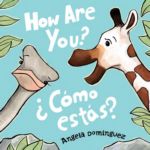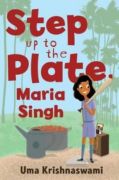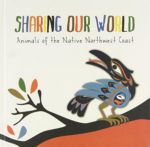
Friendship awaits in this book about feelings, expressed both in English and in Spanish.

Friendship awaits in this book about feelings, expressed both in English and in Spanish.

Maya and Annie are friends who play together on Saturdays and Sundays. They make lemonade with lemons from the big tree in Annie’s yard and play with Maya’s two little dogs. Maya likes the different food Annie s dad cooks: noodles, rice, fish and dumplings. And Annie likes eating dinners Maya s mom makes: tacos, chicken, tamales and rice and beans.

Including easy-to-make recipes, this bilingual picture book for children ages 4-8 will have them clamoring for a garden of their own to plant and harvest. Along the way, young readers and the adults in their lives too will learn that coming together as a community will enable them to harvest more than just vegetables.

Arturo and his grandmother return in this charming bilingual sequel. Abue Rosa and Arturo are making a welcome dinner for Tia Ines’ new fiancé using plaintains, pollo, and pastel. With a bit of creativity, Arturo takes charge and creates a welcome feast like no other. Charming illustrations infused with the colors of the Southwest bring this touching story to life. A glossary at the end provides explanations and pronunciation for key words.

A girl expresses her love of the river that she visits, plays in, and cares for throughout the year.

Astronaut John Herrington shares his passion for space travel and his Chickasaw heritage as he gives children a glimpse into his astronaut training at NASA and his mission to the International Space Station. Learn what it takes to train for space flight, see the tasks he completed in space, and join him on his spacewalk 220 miles above the earth. This unique children s book is illustrated with photos from Herrington’s training and space travel and includes an English-to-Chickasaw vocabulary list with space-related terms.

Love Beyond Body, Space, and Time is a collection of indigenous science fiction and urban fantasy focusing on LGBT and two-spirit characters. These stories range from a transgender woman undergoing an experimental medication that enables her to live the lives of her maternal ancestors to young lovers separated through decades and meeting in the future. These are stories of machines and magic, love and self-love.

During the school day, Lance García looks like a typical fourth-grader at Oakland Elementary School. But after school, dressed in disguise black jacket, black baseball cap and dark, cool sunglasses with tiny, rectangular mirrors so he can see who’s behind him he checks the mailbox labeled Malo Mail. No one realizes that he is the infamous Mister Malo, righter of wrongs, punisher of bullies.

Nine-year-old Maria Singh learns to play softball just like her heroes in the All-American Girls’ League, while her parents and neighbors are struggling through World War II, working for India’s independence, and trying to stay on their farmland.

Sharing Our World, by First Nations and Native artists: honoring Ancestors, the Totem, and 15 animals native to the NW coast.